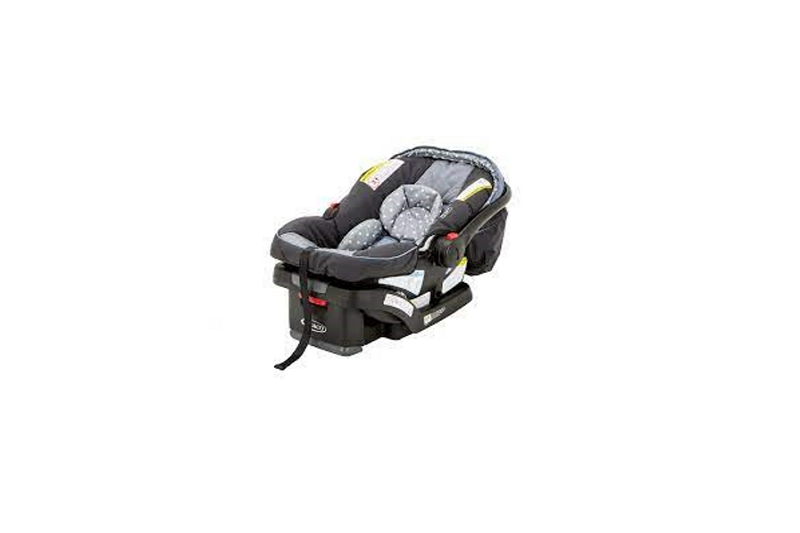When to take baby out of infant car seat? There are many reasons why you would want to remove your child from an infant car seat, be it for a nap or when they fall asleep in the backseat on the way home.
However, there is one big reason not to do this and that’s safety. If you take your sleeping baby out of their car seat while they’re still buckled up (and with the top strap fastened snugly), then all bets are off; danger could quickly become imminent if you don’t follow proper procedures before doing so.

To summarize: never unbuckle a harnessed child who isn’t already standing next to their seat! Here’s how it should work: Once securely belted into his/her car seat, make sure your baby’s head is supported before you release the bottom buckle.
As long as your infant remains asleep in their harnessed restraint, they’re safe; if they awaken or stir while still buckled up (and with the top strap fastened snugly), then simply don’t remove them from it until safely at home and ready for bedtime — when all of these safety precautions can finally be dispensed with.
Can I put my 5-year-old in a booster seat?
The answer is yes, you can put your child in a booster seat. Most kids outgrow their car seats before they reach the age of five and need to be moved into a booster seat.
How much do you have to weigh to sit in a backless booster seat?
The manufacturer’s instructions are the best guide for how much a child weighs to sit in a backless booster seat. However, there is no exact weight requirement like with standard car seats and boosters.
Generally speaking, children should be over 40 lbs (18 kg) or at least four years old before sitting in this type of car seat without an additional harness system. If you have any doubts about whether your child meets these guidelines, check his height instead since most manufacturers will provide weight guidelines by height rather than age alone.
For example: if your five-year-old is 50 inches tall he may need to use a highback booster if he has outgrown his convertible model that requires only forward-facing installation using the vehicle lap/shoulder belt.
On the other hand, if your five-year-old weighs 45 lbs and is 48 inches tall he could still use a backless booster seat that only requires installation using a lap belt but has no upper height or weight limit.
When can my child switch to a backless booster?
Typically, you can switch to a backless booster once your child has weighed 40 pounds and is between the ages of four and eight years old. However, it’s best not to wait that long as they need 80-100 pounds for a seat belt to properly fit.
The Centers for Disease Control also state that children who are under 12 years of age should be restrained in either a car seat or booster with the lap/shoulder belts until they have reached at least 57 inches tall. Car accidents can happen anywhere so don’t leave this step out!
How tight should a booster seat fit?
A booster seat should be tight enough so that your child does not wiggle around in it.
If the belt is positioned on their tummy, they are too loose. If the belt rides up to near or under their arm, they are too tight! The shoulder strap needs to go over the middle of your child’s shoulder (and chest).
And if you’re lucky enough for them to stay seated properly when they get out of a car – great job! That means you’ve chosen well and installed it correctly! Have fun exploring with an extra-secure ride whenever possible.
You can also use this rule of thumb:
Seats that don’t adjust forward/backwards (like high back boosters) will need more space between the seat and the vehicle seat for your child’s legs to fit under.
A booster that adjusts forward/backwards (like backless boosters) will need less space between the seat and the vehicle seat for your child’s legs to fit comfortably underneath.
Booster seats should be tight enough so that they don’t wiggle around in them. If the belt rides up near their arm, it’s too tight; if it goes on their tummy, then it’s too loose. The shoulder strap needs to go over the middle of their shoulder (and chest).
And even better than just staying seated properly when they get out of the car, is if they can stay seated properly when getting in and out. That means you’ve chosen well and installed it correctly! Have fun exploring with an extra-secure ride whenever possible.
You could also use this rule of thumb: Seats that don’t adjust forward/backwards (like high back boosters) will need more space between them and the vehicle seat for their legs to fit under.
A booster that adjusts forward/backwards (like backless boosters) will need less space between them and the vehicle seat for their legs to fit comfortably underneath.
